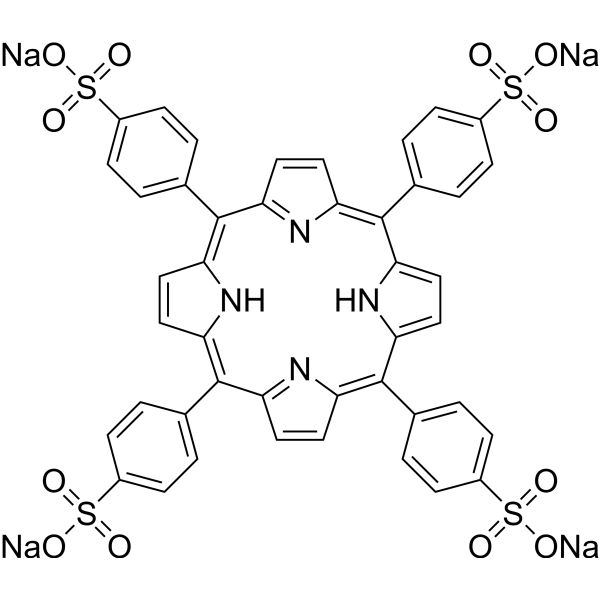39050-26-5
| 中文名 | meso-四(4-磺苯基)卟吩四钠十二水 |
|---|---|
| 英文名 | meso-Tetrakis(p-sulfophenyl)porphine tetrasodium salt |
| 中文别名 |
四(4-磺酸基苯基)卟啉四钠盐
MESO-四(4-磺基苯基)卟啉四钠盐十二水合物 21H,23H-卟啉-5,10,15,20-四对苯磺酸钠 |
| 英文别名 |
tetrasodium-meso-tetra(4-sulfonatophenyl)porphinedodecahydrate,min.
Na4[H2tpps] 5,10,15,20-Tetrakis[4-(sodiooxysulfonyl)phenyl]-21H,23H-porphyrin TETRASODIUM-MESO-TETRA(4-SULFONATOPHENYL)PORPHINE DODECAHYDRATE 5,10,15,20-Tetrakis[4-(sodiosulfo)phenyl]-21H,23H-porphyrin 5,10,15,20-Tetraphenyl-21H,23H-porphine-p,p',p'',p'''-tetrasulfonic acid tetrasodium salt TETRASODIUM-MESO-TETRA(4-SULFONATOPHENYL)PORPHINE 5,10,15,20-Tetrakis(sodium 4-sulfonatophenyl)-21H,23H-porphyrin meso-Tetrakis-(4-sulfophenyl)-porphine tetrasod tetrasodium meso-5,10,15,20-tetrakis(p-sulfonatophenyl)porphyrin sodium |
| 描述 | TSPP四钠是一种光敏剂,在体内治疗癌症和微生物感染(Ex:413 nm,Em:640 nm)方面表现出显著效果[1][2]。 |
|---|---|
| 相关类别 | |
| 参考文献 |
| 密度 | 1.607g/cm3 |
|---|---|
| 分子式 | C44H26N4Na4O12S4 |
| 分子量 | 1022.92 |
| 精确质量 | 957.06400 |
| PSA | 307.30000 |
| LogP | 8.17620 |
| 外观性状 | Powder | purple |
| 储存条件 | 室温 |
| 计算化学 | 1、 疏水参数计算参考值(XlogP):5.4 2、 氢键供体数量:6 3、 氢键受体数量:14 4、 可旋转化学键数量:8 5、 拓扑分子极性表面积(TPSA):275 6、 重原子数量:64 7、 表面电荷:0 8、 复杂度:1960 9、 同位素原子数量:0 10、 确定原子立构中心数量:0 11、 不确定原子立构中心数量:0 12、 确定化学键立构中心数量:0 13、 不确定化学键立构中心数量:0 14、 共价键单元数量:1 |
|
Section 1: Product Identification Chemical Name:Tetrasodium-meso-tetra(4-sulfonatophenyl)porphine dodecahydrate, min. 95% CAS Registry Number:39050-26-5 Formula:C44H26N4Na4O12S4.12H2O EINECS Number:none Chemical Family:metal porphine (porphyrin) complex Synonym:none
Section 2: Composition and Information on Ingredients IngredientCAS NumberPercentACGIH (TWA)OSHA (PEL) Title Compound39050-26-5100%no datano data Section 3: Hazards Identification Emergency Overview:No particular hazard associated with this material. Primary Routes of Exposure:Ingestion, inhalation Eye Contact:May cause slight to mild irritation of the eyes. Skin Contact:May cause slight to mild irritation of the skin. Inhalation:May be irritating to the nose, mucous membranes and respiratory tract. Ingestion:No specific information is available on the physiological effects of ingestion. Acute Health Affects:May be irritating to skin, eyes and respiratory tract. Chronic Health Affects:No information available on long-term chronic effects. NTP:No IARC:No OSHA:No SECTION 4: First Aid Measures Immediately flush the eyes with copious amounts of water for at least 10-15 minutes. A victim may need Eye Exposure: assistance in keeping their eye lids open. Get immediate medical attention. Wash the affected area with water. Remove contaminated clothes if necessary. Seek medical assistance if Skin Exposure: irritation persists. Remove the victim to fresh air. Closely monitor the victim for signs of respiratory problems, such as difficulty Inhalation: in breathing, coughing, wheezing, or pain. In such cases seek immediate medical assistance. Seek medical attention immediately. Keep the victim calm. Give the victim water (only if conscious). Induce Ingestion: vomiting only if directed by medical personnel. SECTION 5: Fire Fighting Measures Flash Point:no data Autoignition Temperature:none Explosion Limits:none Extinguishing Medium:carbon dioxide, dry powder or foam If this material is involved in a fire, fire fighters should be equipped with a NIOSH approved, positive pressure Special Fire Fighting Procedures: self contained breathing apparatus and full protective clothing. Hazardous Combustion andIf involved in a fire this material may emit toxic organic fumes. Decomposion Products: Unusual Fire or Explosion Hazards: No unusual fire or explosion hazards. SECTION 6: Accidental Release Measures Spill and Leak Procedures:Small spills can be mixed with vermiculite or sodium carbonate and swept up. SECTION 7: Handling and Storage Handling and Storage:Store in a tightly sealed container. Keep away from heat and direct sunlight. SECTION 8: Exposure Controls and Personal Protection Eye Protection:Always wear approved safety glasses when handling a chemical substance in the laboratory. Skin Protection:Wear protective clothes and gloves. Consult glove manufacturer to determine the proper type of glove. Ventilation:Material may form a fine dust. If possible, handle the material in an efficient fume hood. If ventilation is not available a respirator should be worn. The use of respirators requires a Respirator Respirator: Protection Program to be in compliance with 29 CFR 1910.134. Ventilation:Material may form a fine dust. If possible, handle the material in an efficient fume hood. Additional Protection:No additional protection required. SECTION 9: Physical and Chemical Properties Color and Form:purple pwdr. Molecular Weight:1022.87 (1239.11) Melting Point:no data Boiling Point:no data Vapor Pressure:not applicable Specific Gravity:no data Odor:none Solubility in Water:very soluble SECTION 10: Stability and Reactivity Stability:air and moisture stable solid Hazardous Polymerization:no hazardous polymerization Conditions to Avoid:none Incompatibility:oxidizing agents Decomposition Products:carbon dioxide, carbon monoxide, nitrogen oxides, sulfur dioxide, organic fumes, and sodium oxide SECTION 11: Toxicological Information RTECS Data:No information available in the RTECS files. Carcinogenic Effects:No data available Mutagenic Effects:No data available Tetratogenic Effects:No data available SECTION 12: Ecological Information Ecological Information:No information available SECTION 13: Disposal Considerations Disposal:Dispose of according to local, state and federal regulations. SECTION 14: Transportation Shipping Name (CFR):Non-hazardous Hazard Class (CFR):NA Additional Hazard Class (CFR):NA Packaging Group (CFR):NA UN ID Number (CFR):NA Shipping Name (IATA):Non-hazardous Hazard Class (IATA):NA Additional Hazard Class (IATA):NA Packaging Group (IATA):NA UN ID Number (IATA):NA SECTION 15: Regulatory Information TSCA:Listed in the TSCA inventory. SARA (Title 313):Not reportable under SARA Title 313 Second Ingredient:none SECTION 16 - ADDITIONAL INFORMATION N/A |


